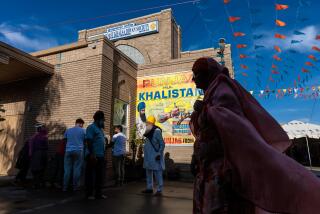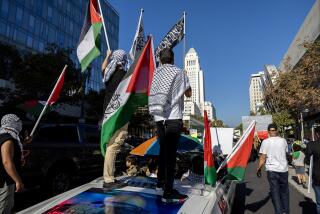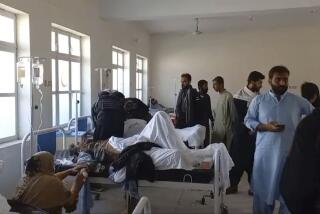A Quiet Throng Hopes to Show ‘Correct Islam’
- Share via
RAIWIND, Pakistan — They came here clinging to the tops of buses, spilling out of tractor-pulled wagons. They came on horseback and in limousines. By the time of fajar, the sunrise prayer Friday, they had formed in rows of supplicants nearly a mile long and more than a quarter-mile wide.
Pakistan’s annual Tablighi Ijtimah, or Congregation of Preachers, is one of the largest gatherings of Muslims in the world. Yet because it is almost always conducted in a spirit of moderation and civility, it gets little of the attention paid to the much smaller fundamentalist movements here, particularly in these tense recent weeks.
On Friday, for example, a demonstration of 6,000 members of the pro-Taliban Jamaat-i-Islami party drew squads of foreign reporters to Mardan, northwest of Islamabad, the capital. Similar demonstrations, marked by fiery rhetoric and flaming effigies, were held in other cities, usually under the scrutiny of television lenses.
But on the same day, more than 500,000 evangelical Muslims gathered here on a 400-acre site in rural Punjab province with only scant notice taken by any media, local or foreign.
Part of the reason is that the tablighis, as the participants call themselves, shun publicity and photography, which they view as vanity. Followers of an evangelical movement founded 51 years ago in India, they believe that Islam should be spread by setting a good example--one of modesty and nonviolence.
“We don’t want to show off or publicize what we are doing,” said Mohammed Khurshid Haq, a Punjab civil engineer who organized this year’s massive four-day meeting. “Islam is in the world to guide people, not to kill them. We want to show the world the correct Islam.”
Khurshid estimated the crowd this year at more than 1 million, but that number was impossible to verify because of the nature of the gathering. Foreign pilgrims, Khurshid acknowledged, were fewer than normal because of the conflict in neighboring Afghanistan.
The logistics presented by such a crowd are staggering, requiring electricity plants and central supply depots.
The long galvanized sinks used for ablution, the ritual cleansing, took up several acres alone. Sanitation trucks plied the perimeters of the meeting ground collecting trash.
The worship area was partitioned and covered with what organizers said was miles of white cotton fabric, sewn together by volunteers and propped up with long bamboo poles.
One of the volunteers, Sher Niwaz, 38, a broad-shouldered ethnic Pushtun from the northern city of Peshawar, said he quit his job as a teacher to work for a year helping to set up the meeting here.
“All of the arrangements are by the people, no government involved,” he said proudly. He introduced a pair of visiting journalists to curious onlookers as “our Muslim brothers from America.”
Volunteers also staffed several cavernous cafeteria tents where a meal of flat bread, meat and lentils cost the equivalent of 25 cents. When private concessionaires tried to enter the main compound, they were shooed away by security volunteers with long bamboo poles.
Police and constables stayed outside the religious camp, spending most of their time directing traffic or using forklifts to remove illegally parked cars.
But because of the extra tensions this year caused by the conflict in Afghanistan, local Lahore-area authorities added 2,000 police officers to the security detail. As of late Friday, it seemed unnecessary.
It wouldn’t be true to say that the tablighi movement is completely apolitical. In 1998, when Nawaz Sharif was prime minister, parliament elected Mohammed Rafiq Tarar, a follower of the movement, as the country’s figurehead president. Likewise, authors of a failed coup against former Prime Minister Benazir Bhutto had tablighi influences.
Nor would it be accurate to say that the movement is devoid of fundamentalist tendencies. Some in Pakistan have accused the movement of being a breeding ground for Islamic militancy, particularly in the missionary schools it operates. Some of the hundreds of vehicles parked at the meeting site bore portraits of Saudi militant Osama bin Laden.
But by and large, the movement appears to fit the mold of moderate Islam that President Pervez Musharraf says is the true image of Pakistan.
The speakers, both religious leaders and lay members of the movement, didn’t neglect the pressing issues of Muslims worldwide: the fate of Afghan civilians under the barrage of U.S. bombing and the condition of Palestinians and Kashmiri Muslims. But the solutions outlined are decidedly different from those of militant Islam.
“The destruction of the bombing will end, but it will end from the heart,” said Saqib Ali, 24, a computer science student from Faisalabad, west of here.
“The beard,” Khurshid said, stroking his tangled white mop, “is not a sign of terrorism. All of the prophets had beards.”
Surrounding him Friday was a hirsute sea of Muslim pilgrims: towering, black-bearded Pushtuns from the wild North-West Frontier Province. Men with brown broom-brush beards from sultry, southern Sindh. Wisp-bearded youngsters from desert Baluchistan.
There was not an angry word in the crowd. The only raised voices were those of “God is Great.”
Khurshid and others here have been stung by the image of Islamic rage presented by Jamaat-i-Islami and other militant movements.
“They create this image of death and fire,” Khurshid said. “We want to tell the people of the world that Islam is a peaceful religion. We are here to restore honor to the world.”
More to Read
Sign up for Essential California
The most important California stories and recommendations in your inbox every morning.
You may occasionally receive promotional content from the Los Angeles Times.













